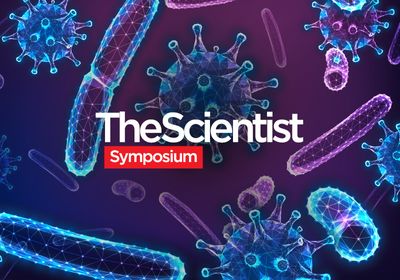ABOVE: A pseudocolored scanning electron micrograph of a 14-week-old human fetal intestine
THET TUN AUNG AND BENOIT MALLERET, NUS YONG LOO LIN SCHOOL OF MEDICINE
Update (November 24): In a letter to Cell published today, a group of researchers argues that Ginhoux and colleagues' study did not adequately control for the possibility of contamination of samples, and that better-designed studies have found no evidence that fetuses are colonized with microbes. The study authors defend their methods in a separate letter published today.
Over the last decade, scientists have shown that the fetal immune system comes online much sooner than was initially thought, but what type of antigens train nascent immune cells and how this affects subsequent development remain open questions. In a study published June 1 in Cell, researchers determined that second-trimester human fetuses harbor live bacteria in tissues all over their bodies that can activate fetal T cells.
“What is exciting to me about this paper is that it provides evidence, not only that there is microbial exposure in utero . . . but that it is important for education of the developing fetal immune system—especially memory T cells, which are important then for preparing the newborn to deal with additional antigenic exposures, microbial exposures, and possible infectious pathogenic exposures,” says Indira Mysorekar, a biologist at Washington University School of Medicine who authored a commentary that will appear in Cell about the new study. “It supports other studies that have come out recently that suggest that there is in utero exposure and that fetal [immune] education commences in utero.”
In 2017, immunologist Florent Ginhoux of A*STAR in Singapore and colleagues showed that the fetal immune system is operational by the second trimester of pregnancy. “It looks like the fetal immune system is quite functional quickly and early,” he explains. The findings ran contrary to the long-held assumption that babies receive their first big immune challenge when they are born and come into contact with the outside world, starting with the vaginal microbiome, he adds. While work from other groups has confirmed the second trimester appearance of the fetal immune system, it’s still not clear what antigens fetal immune cells recognize.
To answer this question, Ginhoux again teamed up with Jerry Chan and Salvatore Albani of the Duke-NUS Medical School in Singapore and Naomi McGovern, a former postdoc at A*STAR who now runs her own lab at the University of Cambridge in the UK. The researchers used 16S ribosomal RNA sequencing on various fetal and placental tissues—obtained from abortions during the second trimester—to show that there were traces of microbes present in the fetal gut, lungs, and skin, as well as in the placenta.
To rule out contamination as the source of the bacterial DNA, the researchers sent fetal samples to collaborators at the Weizmann Institute in Israel, who also found evidence of bacterial DNA. The team also sequenced numerous controls: the buffers used to clean tools in the hospital and in the lab, swabs from the hands of researchers who handled fetal samples and touched any surface the fetal tissue may have contacted, and all the reagents that were used to extract and sequence DNA.
By comparing the signal from the controls to those from the fetal tissues, the team identified a genetic signature corresponding to specific microbes present in the fetuses. “It’s a low biomass signal, but it’s unlikely to be noise,” says Ginhoux.
The team grew live bacteria from fetal tissue in culture, including some of those specific microbes that were not found in the controls. Then, they prepared fetal guts—the tissue that showed evidence of the largest microbial community, aside from the skin—for scanning electron microscopy. The gut tissue came from one fetus at 10 weeks estimated gestational age and three at 14 weeks estimated gestational age. “To our surprise, we could find microbes” in the guts of the 14-week-old fetuses, but not the 10-week-old, Ginhoux says, which suggests that the bacteria colonize the gut after a certain point in development. The bacteria were located only in specific areas in the intestinal lumen, in structures that looked as though they were bound to mucin, a mucus-like substance released by epithelial cells.

Finally, the researchers showed that some of the bacterial species they found in the fetuses could activate memory T cells isolated from fetal tissues in an in vitro system they designed to monitor T cell activation and expansion. “The T cells that we find activated in the tissue, some of them are likely to have been educated or have been activated to respond to the microbes that were isolated,” Ginhoux explains. The findings indicate that microbes are one of the factors involved in early human immune development and “may be the basis for that lifelong human health and immunity.”
“It’s very intriguing to think that you’re getting this early exposure to bacteria,” says Donna Farber, an immunologist at Columbia University who did not participate in the study. “And then the question is, where is that bacteria coming from?” she asks.
“Vertical transmission of microbial organisms from mother to child is a completely unknown mechanism,” Ginhoux agrees. “There is so much communication and exchange between the mother and the fetus during development.”
Another open question, according to Mysorekar, is how the in utero exposure to microbes affects fetal immune development. “What are the signals that are being sensed or received by the fetal immune cells that are initiating their education?” she asks. This work “nudges open the field and really underscores that there are a lot of questions to be addressed.”







